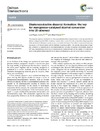Please use this identifier to cite or link to this item:
https://accedacris.ulpgc.es/handle/10553/69280
| DC Field | Value | Language |
|---|---|---|
| dc.contributor.author | Azofra Mesa, Luis Miguel | en_US |
| dc.contributor.author | Poater, Albert | en_US |
| dc.date.accessioned | 2020-01-23T12:56:13Z | - |
| dc.date.available | 2020-01-23T12:56:13Z | - |
| dc.date.issued | 2019 | en_US |
| dc.identifier.issn | 1477-9226 | en_US |
| dc.identifier.other | WoS | - |
| dc.identifier.uri | https://accedacris.ulpgc.es/handle/10553/69280 | - |
| dc.description.abstract | The proposed reaction mechanism for the unprecedented direct transformation of primary alcohols into alkenes catalysed by Mn(i)-PNP complexes consists of two cycles. First, the acceptorless dehydrogenation of the alcohol into aldehyde is produced via a concerted mechanism. Secondly, in an excess of hydrazine, hydrazone is formed and reacts with the aldehyde to produce olefins. This process, taking place in base-free conditions, is characterised by the diastereoselective formation of diazenyl intermediates. Based on DFT data, the generation of the (S-N,S,S) diastereoisomer is favoured over the rest, leading in its decomposition to the preferential formation of an (E)-alkene and liberating N-2 and H2O as the only by-products. | en_US |
| dc.language | eng | en_US |
| dc.relation.ispartof | Dalton Transactions | en_US |
| dc.source | Dalton Transactions [ISSN 1477-9226], v. 48 (37), p. 14122-14127 | en_US |
| dc.subject | 3303 ingeniería y tecnología químicas | en_US |
| dc.subject.other | Amines | en_US |
| dc.subject.other | Ligand | en_US |
| dc.subject.other | Approximation | en_US |
| dc.subject.other | Hydrogenation | en_US |
| dc.subject.other | Aldimines | en_US |
| dc.subject.other | Complexes | en_US |
| dc.subject.other | Oxidation | en_US |
| dc.subject.other | Nitriles | en_US |
| dc.subject.other | Energy | en_US |
| dc.subject.other | Form | en_US |
| dc.title | Diastereoselective diazenyl formation: the key for manganese-catalysed alcohol conversion into (E)-alkenes | en_US |
| dc.type | info:eu-repo/semantics/Article | en_US |
| dc.type | Article | en_US |
| dc.identifier.doi | 10.1039/c9dt03379c | en_US |
| dc.identifier.scopus | 85072588662 | - |
| dc.identifier.isi | 000487514400025 | - |
| dc.contributor.authorscopusid | 55142490200 | - |
| dc.contributor.authorscopusid | 8533443400 | - |
| dc.identifier.eissn | 1477-9234 | - |
| dc.description.lastpage | 14127 | en_US |
| dc.identifier.issue | 37 | - |
| dc.description.firstpage | 14122 | en_US |
| dc.relation.volume | 48 | en_US |
| dc.investigacion | Ingeniería y Arquitectura | en_US |
| dc.type2 | Artículo | en_US |
| dc.contributor.daisngid | 1089199 | - |
| dc.contributor.daisngid | 141031 | - |
| dc.utils.revision | Sí | en_US |
| dc.contributor.wosstandard | WOS:Azofra, LM | - |
| dc.contributor.wosstandard | WOS:Poater, A | - |
| dc.date.coverdate | Octubre 2019 | en_US |
| dc.identifier.ulpgc | Sí | en_US |
| dc.description.sjr | 1,048 | |
| dc.description.jcr | 4,174 | |
| dc.description.sjrq | Q1 | |
| dc.description.jcrq | Q1 | |
| dc.description.scie | SCIE | |
| item.fulltext | Con texto completo | - |
| item.grantfulltext | open | - |
| crisitem.author.dept | GIR IUNAT: Fotocatálisis y espectroscopía para aplicaciones medioambientales. | - |
| crisitem.author.dept | IU de Estudios Ambientales y Recursos Naturales | - |
| crisitem.author.orcid | 0000-0003-4974-1670 | - |
| crisitem.author.parentorg | IU de Estudios Ambientales y Recursos Naturales | - |
| crisitem.author.fullName | Azofra Mesa, Luis Miguel | - |
| Appears in Collections: | Artículos | |
SCOPUSTM
Citations
19
checked on Jun 8, 2025
WEB OF SCIENCETM
Citations
19
checked on Jun 8, 2025
Page view(s)
129
checked on May 31, 2025
Download(s)
206
checked on May 31, 2025
Google ScholarTM
Check
Altmetric
Share
Export metadata
Items in accedaCRIS are protected by copyright, with all rights reserved, unless otherwise indicated.
